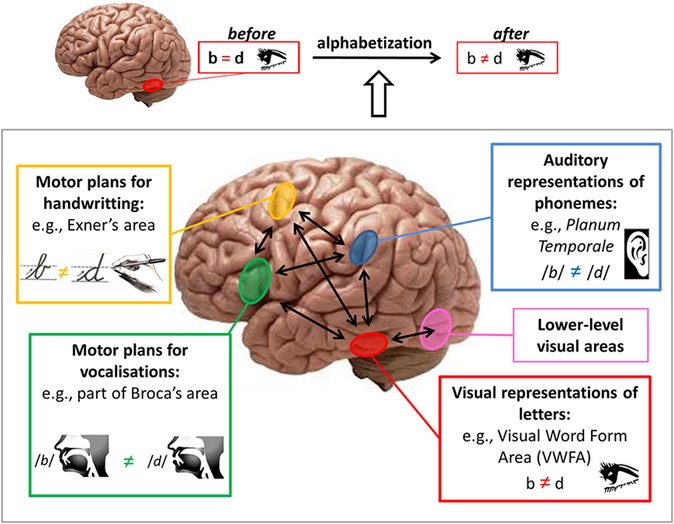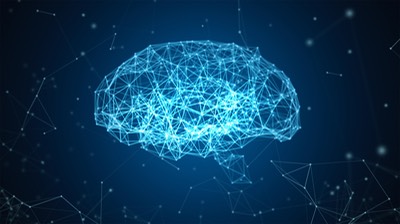With Neuron Trek, students begin reading using Rhythm, Rhyme, and the Bigram approach to phonics, what we call “Bigram Raps.” (Plus a little bit of dancing!) By breaking learning into basic brain functions, we can progress faster, and exercise weak areas in the brain. Learning phonics by bigrams is an idea inspired by neuroscientist Stanislas DeHaene.* Also see principles #2 and #3 below.
The Case for Bigrams in Phonics:
Thanks to soundbible.com
From- Pegado F, Nakamura K and Hannagan T (2014) "How does literacy break mirror invariance in the visual system?” (Also see below.****)

Visual Word Form Area Connects with Language Networks in the Left Hemisphere
Symbol Processing- Rapid decoding of symbols is the most basic skill needed for decoding letters. We can exercise this skill using simple symbols like arrows. This is good for everyone, children and adults because as neuroscientist Mike Merzenich says, “The brain will almost always process things faster if you ask it to.”** But this “asking” involves practice.
Advantages in the Bigram Raps:
The short version (more details below)-
Showing vs Telling: When you tell students something you run the risk of it going “in one ear and out the other.” But if you show them, it’s like “Aha!” That’s what the bigram raps do. They form an association between the letters seen and the sound heard.
Implicit vs Explicit: We learn oral language mostly spontaneously by subconsious associations (implicitly). Reading is another story, but often tends to be taught too explicitly. We take advantage of both methods- The implicit connection becomes more explicit (conscious) as the student speaks the sounds, then hand-writes (prints) them. (See #4 below.)
Still vs Moving images: We don’t think of words as moving, but in fact they move across the visual field as we scan the page (250wpm = 11 mph!). The bigram videos use still images, which help students who have eye movement issues. As they learn from flashes of still images, they can improve eye movements through the exercises on this page.
More specific neuro-principles involved:
1- Incremental- Bit by bit! All teachers use an incremental approach to learning, involving breaking it into smaller steps. Bigrams are incremental, but you might think, “Aren't letters smaller steps than bigrams?” Yes, that’s why we have an alphabet page, but there are important reasons why bigrams are better steps than teaching letter-by-letter. See #3 below…
2- Brain-based- According to neuroscientist Stanislas Dehaene's theory, bigrams/trigrams are the way the brain processes phonics. Later, letter clusters and sight words develop, although DeHaene cautions against whole word processing without learning the phonics first. Let's work with the brain!
3- Letter order- “It's the letters at the end that make the call.” Students shouldn't have to read backwards! The fact is, most of the time it's the letter following a letter that affects its sound. Think of the “o” in “no.” Adding “t'” to make “not” changes the “o” to “ah,” and adding “e” to “not” makes “note,” changing the “o” sound back again. “Wait what?” says the student.
If we try to read letter by letter, we have to look ahead, and then go back constantly. Decoding by Bigrams/Trigrams eliminates this by learning the letters in pairs or triplets. It may seem like bigger steps than letter-by-letter, but in the end these are more efficient steps, especially for students with eye movement difficulties. No wonder that the brain processes this way! Thank you, DeHaene!
4- Implicit Learning- “Neurons That Fire Together, Wire Together.” (NTFTWT) This Hebb Principle shows that neurons firing simultaneously make connections, even if they're in different parts of the brain, and even if we're unaware of this concerted firing.*** Hebb did experiments proving that exposing people to subconscious patterns caused them to form lasting memories of those patterns.
This is similar to when a parent reads to their child. They are not consciously teaching them how to read words, but eventually the child picks up the subconscious patterns making it easier to learn to read consciously. In the videos, the bigrams are more direct learning (though still following Hebb's “firing together”), whereas the rhyming words are more implicit.
5- Making learning fun! This not only improves motivation, but improves the brain. Since the raps involve rhythm and rhyme (and colors), they stimulate synapses to produce more receptors (Max Cynader), thus strengthening connections.
Should a child be encouraged to get up and dance during a lesson? Isn't this distracting? Well, to start with, motivation is a key part of distant learning. And, as a matter of fact, physical exercise is one of the best ways to cause neurogenesis, the creation of new neurons. (Yes, this happens, especially in the hippocampus.) This may be because exercise causes the brain to produce BDNF (Brain-Derived Neurotrophic Factor), a protein which increases brain growth. It stands to reason that producing BDNF during learning, will enhance what learning is taking place at the time, (though I'm not sure this has been proven).
6- Eye Movement issues- In the videos, the bigrams flash one at a time, instead of moving across the page. If a student has eye movement problems (see Magnocellular Deficit), it may be difficult to learn to read, just because the eyes aren't tracking correctly while they move across the page. Having the bigrams as still images helps eliminate this.
Note- You may say, “Well, doesn't the student eventually have to learn how to scan the page?” Yes! And I've included exercise videos to help with eye movements to be able to do this. But in the mean time, the bigram videos allow them to separate these two skills. (This uses the Arrowsmith principle and the constrained-induced therapy principle.)
7- Auditory Processing- Say what? In the 80% videos, the sound is slowed down, not just to make it easier to learn, but if a student has an auditory processing deficit, the sounds themselves are difficult to distinguish.
Note: Neuroscientist Paula Tallal says that the difference between a “d” sound and “b” sound is only about 40 milliseconds at the start of the sound. This is one reason why these letters are hard for some to distinguish. Percussive consonants like d and b are hard to slow down during speech, but in a recording, they can be stretched out digitally, making this 40ms more accessible. I'll be adding more 'stretched' recordings to help students with slow auditory processing.
8- The Phonological Loop- saying the sounds. An important part of this learning is creating a loop from visual and auditory processing to motor processing and back to auditory (hearing their own voices saying the sounds). This reinforces the 'symbols into sounds' aspect of learning to read. Once again the Hebb Principle comes into play.
In the classroom, this is easy, though it may be hard in a group setting to pick out each student. With virtual learning, this could be done with individual video chats, or by making sure that each student has the availability of sound recording, which the teacher could review at a later time.
* Stanislas DeHaene, reading in the brain 2009
*** NTFTWT- https://en.wikipedia.org/wiki/Hebbian_theory
**** By Pegado F, Nakamura K and Hannagan T - Pegado F, Nakamura K and Hannagan T (2014) How does literacy break mirror invariance in the visual system? Front. Psychol. 5:703. doi: 10.3389/fpsyg.2014.00703 http://journal.frontiersin.org/article/10.3389/fpsyg.2014.00703/full, CC BY 3.0, https://commons.wikimedia.org/w/index.php?curid=44059451
